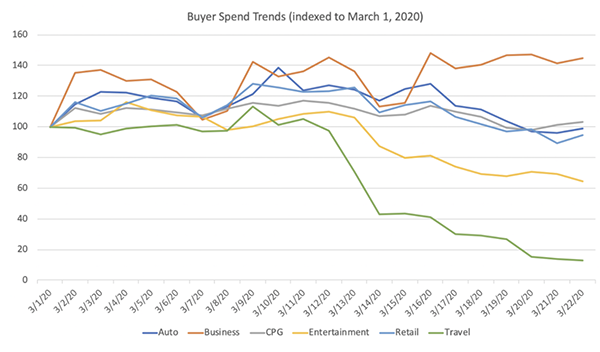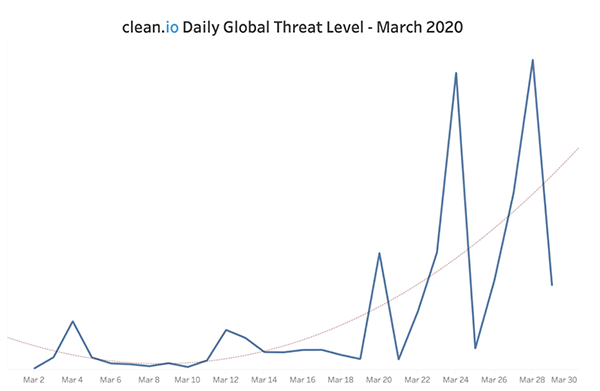 |
||||||||||||||
|
||||||||||||||
| Ad Spend Hasn’t Dried Up Yet |
| Publishers probably feel like they’ve been placed under quarantine by their advertisers lately, and new data from an IAB survey of media buyers, planners, and brands is only going to strengthen that sentiment. About a quarter of respondents have paused all advertising for the remainder of Q1 and Q2, with another 46% admitting they had “adjusted” (read: decreased) their spend for this time period. And it’s set to be a 20% decrease in upfront spending—which VideoNuze notes could be $4 billion. The real gut punch is that 74% of respondents think that the current pandemic will have a more drastic effect on advertising than the 2008 financial crisis. For those that remember, 2008-2009 was pretty much the Dark Ages of digital media monetization. |
| But 2008 is also an interesting comparison point. In the midst of the Great Recession, real-time bidding found roots in digital media and grew at a ludicrous rate. As we’re waving goodbye to the third-party cookie and having a lot of questions about potential replacements, maybe this painful transition period will illuminate the best path forward when it comes to targeting audiences and measuring campaigns. (Or maybe we’re squinting too hard to see a silver lining...) Anyway, it’s not all bad news in the survey—the IAB finds many advertisers are changing tactics (as AdMonsters expected) away from reserved buys and into programmatic. Thirty-eight percent of survey respondents said they were increasing spend in audience targeting (vs. 15% decreasing); 35% bumping up connected TV spend (15% decreasing), and… 34% increasing mobile device targeting (11% decreasing). Huh, maybe coronavirus will make 2020 the year of mobile after all. And maybe there’s some relief that digital media is expected to take less of a ‘rona hit than print media (where many regional newspapers are already cutting the size and regularity of editions) and recover faster? Nah, not really. |
| Reading the Vertical Trends |

Source: Index Exchange
|
| While IAB was surveying brands and agencies, Index Exchange took a hard look at the spend from certain verticals coming through its pipes. Unsurprisingly, travel and entertainment have taken serious dives, but other industries haven’t seen such dramatic slumps. Media appears to be buoyed by spending from streaming services while large retailers appear to be picking up the slack for smaller ones that have halted advertising. |
| But what’s particularly interesting is CPG spend, which had been holding steady before taking a dip in the last few weeks. Index EVP of Global Marketplace Development Will Doherty, who believes advertisers are taking a moment to “reset” in the blitz of coronavirus news, believes this channel is the one to watch as there’s a potential battle brewing between traditional CPG brands and upstart DTC brands. Noting retail and CPGs represent the highest demand load on the exchange, traditional CPGs might need to exert some more advertising muscle to ensure DTCs don’t invade their turf. “We are all literally a captive audience at home, and they need to leverage programmatic to reinforce their position.” |
| Payment Fail Redux? |
| You’re probably not the only one getting a bad feeling of Sizmek deja vu—citing force majeure, video partner Teads is apparently informing some publisher clients that it may not be able to meet agreed-upon revenue guarantees, according to AdWeek. In addition, in-image and contextual play GumGum is apparently renegotiating payment deals with publishers from net-60 for net-90. |
| Argh, publishers are already having enough trouble drawing revenue from reluctant advertisers and now they have to worry that their ad tech partners might default on them and leave them holding the bag? Wow, this pandemic keeps getting better and better. "Any type of big disruption ends up benefitting Facebook, Google, and Amazon," Sparrow Advisers’ Ana Milicevic told Business Insider. "If [companies] go under, that spend still has to go somewhere." But also think about the sell side’s perspective—if publishers are worried that their small and midsize ad tech partners and demand sources can’t pay the bills, that’s going to prioritize larger exchanges and demand partners with deeper pockets. Top of mind—Google, Facebook, and Amazon. As if the open programmatic ecosystem wasn’t getting squeezed like a lime forced into a Corona longneck… (Too soon?) |
| Malvertisers Pounce on Wounded Pubs |

Source: clean.io
|
| “Lower CPMs and an increase in traffic have created the perfect storm for bad actors to disrupt end-user experiences and impair publisher monetization at a time when publishers can least afford further disruption,” writes Clean.io CEO Matt Gillis in an alarming blog post. Bad actors have smelled publisher blood in the water and have been hitting the exchanges in force since about Mar. 19. Clean.io’s ad quality threat level is around 50 times higher than the baseline set at the beginning of March. |
| As reservations fall to a trickle and buyers even pull back on programmatic, many publishers are having to drop floors to grab any demand they can. And that’s when the trouble begins (or at least worsens)—this is no time for publishers to leave revenue on the table, but they must be extra vigilant watching for low-quality ads. And remember that creative blocking alone cannot serve as a holistic ad-quality strategy. |
| A Lifeline For Local News |
| In recent weeks, we’ve mentioned how unbelievably important local news is during the Coronavirus pandemic. At the same time, many local news outlets are seriously under the gun due to advertisers freezing spending. Just this week, Gannet, one of the country’s largest newspaper companies with over 100 dailies, announced massive furloughs and pay cuts throughout the organization, according to the Daily Beast. Meanwhile, many alt-weeklies around the country have resorted to asking for donations, laying off staff and stopping their print runs altogether, as their main sources of revenue—local bars, restaurants and nightclubs—have had to close their doors in compliance with social distancing measures. And although The Tampa Bay Times has seen a surge in digital subscriptions since the pandemic, it hasn’t been enough to stave off advertising losses, leading to the publisher cutting printing from seven days a week to only two. |
| While we’ve suggested that publishers find alternative means of asking engaged readers for cash—whether through subscription or some other service, we forgot to mention another possible angle for funding—investment. In this case, Facebook is handing out grants to the tune of $100 million—$25 million in grants to local news and $75 million in marketing spend. Other publishers may find beneficiaries with private equity or other types of investors. Thing is—and why we didn’t mention it before—many investors are likely to wait until publishers are at their lowest point before swooping in. But we’re probably not there yet. |





